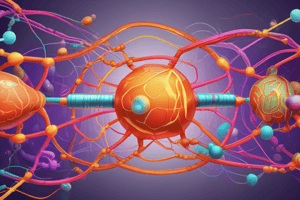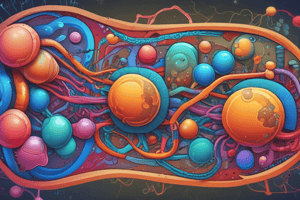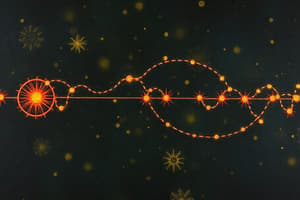Podcast
Questions and Answers
Which molecule donates electrons to Complex I of the electron transport chain?
Which molecule donates electrons to Complex I of the electron transport chain?
- Cytochrome c
- FADH2
- Coenzyme Q
- NADH (correct)
Rotenone inhibits the transfer of electrons from FADH2 to Coenzyme Q.
Rotenone inhibits the transfer of electrons from FADH2 to Coenzyme Q.
False (B)
What is created as protons accumulate in the intermembrane space during oxidative phosphorylation?
What is created as protons accumulate in the intermembrane space during oxidative phosphorylation?
Proton gradient
During ATP synthesis, ADP is phosphorylated to ATP using the _____ motive force.
During ATP synthesis, ADP is phosphorylated to ATP using the _____ motive force.
What is the primary function of ATP synthase (Complex V)?
What is the primary function of ATP synthase (Complex V)?
Match the following inhibitors with their respective targets in the electron transport chain:
Match the following inhibitors with their respective targets in the electron transport chain:
Complex III pumps four protons into the intermembrane space.
Complex III pumps four protons into the intermembrane space.
What term describes the theory that links electron transport to ATP synthesis?
What term describes the theory that links electron transport to ATP synthesis?
Flashcards
Oxidative Phosphorylation
Oxidative Phosphorylation
The final stage of cellular respiration where energy stored in reduced electron carriers (NADH and FADH2) is harnessed to generate ATP.
Electron Carriers
Electron Carriers
Molecules like NADH and FADH2 that carry electrons from glucose breakdown to the electron transport chain.
Electron Transport Chain
Electron Transport Chain
A series of four protein complexes embedded in the inner mitochondrial membrane that pass electrons, releasing energy.
Proton Pumping
Proton Pumping
Signup and view all the flashcards
Proton Gradient
Proton Gradient
Signup and view all the flashcards
ATP Synthase (Complex V)
ATP Synthase (Complex V)
Signup and view all the flashcards
ATP Synthesis
ATP Synthesis
Signup and view all the flashcards
Chemiosmotic Theory
Chemiosmotic Theory
Signup and view all the flashcards
Study Notes
Oxidative Phosphorylation
- What it is: Oxidative phosphorylation is the final stage of cellular respiration where energy stored in reduced electron carriers (NADH and FADH2) is harnessed to generate ATP.
- Electron Carriers:
- NADH and FADH2 carry electrons derived from the breakdown of glucose (glycolysis) and pyruvate oxidation (Krebs Cycle).
- The more reduced a molecule is, the more energy it carries.
- NADH and FADH2 donate their electrons to an electron transport chain.
- Electron transport chain:
- A series of four protein complexes embedded in the inner mitochondrial membrane.
- The complexes work in order: NADH dehydrogenase (Complex I), Succinate dehydrogenase (Complex II), Ubiquinone: cytochrome c oxidoreductase (Complex III), and Cytochrome oxidase (Complex IV).
- Electron flow:
- NADH donates electrons to Complex I, FADH2 donates electrons to Complex II.
- Electrons are passed along the complexes, releasing energy.
- Proton Pumping:
- The energy released during electron transfer is used to pump protons (H+) from the mitochondrial matrix to the intermembrane space.
- Complex I pumps 4 protons.
- Complex III pumps 4 protons (2 directly from QH2 and 2 from the matrix).
- Complex IV pumps 2 protons.
- Proton Gradient:
- As protons accumulate in the intermembrane space, a proton gradient is created across the inner mitochondrial membrane (higher concentration in the intermembrane space).
- This gradient creates a proton motive force, a potential energy source.
- ATP Synthase (Complex V):
- A protein complex that uses the proton motive force to synthesize ATP.
- Composed of two parts:
- F0: spans the inner mitochondrial membrane and acts as a channel for proton flow.
- F1: located on the matrix side and catalyzes ATP synthesis.
- ATP Synthesis:
- As protons flow through F0, it rotates, driving conformational changes in F1, which leads to the phosphorylation of ADP to ATP.
- Chemiosmotic Theory:
- Describes the coupling of electron transport to ATP synthesis by the proton gradient.
- Inhibitors of Electron Transport chain:
- Rotenone: blocks electron transfer from NADH to Coenzyme Q in Complex I.
- Antimycin A: blocks electron transfer from cytochrome b to cytochrome c1 in Complex III.
- Cyanide and Carbon Monoxide: block electron transfer to oxygen in Complex IV.
- Inhibitors of ATP Synthase:
- Oligomycin and DCCD: block the proton flow through F0.
- Uncouplers:
- Dinitrophenol (DNP): transports protons across the mitochondrial membrane, dissipating the proton gradient.
- Natural Uncouplers (Thermogenin): found in brown fat of newborns and hibernating animals, generates heat.
- ATP Yield:
- One glucose molecule produces approximately 32 ATP molecules under aerobic conditions. This includes ATP from glycolysis, the Krebs Cycle, and oxidative phosphorylation.
Studying That Suits You
Use AI to generate personalized quizzes and flashcards to suit your learning preferences.
Description
This quiz covers the essential concepts of oxidative phosphorylation, the final stage of cellular respiration. It explores the roles of NADH and FADH2 as electron carriers, the structure and function of the electron transport chain, and the process of ATP generation. Learn how energy is transferred and utilized in cellular metabolism.




